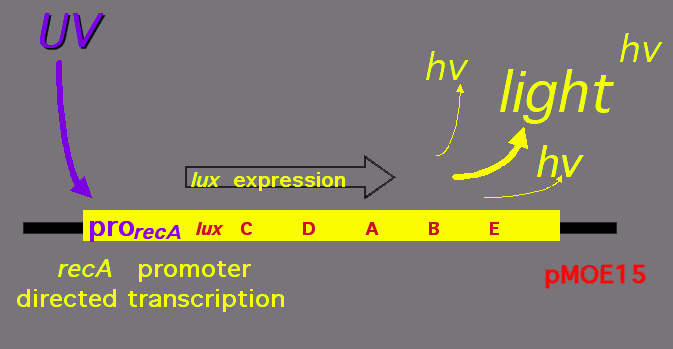Development of a Real-Time Biosensor for Environmental Stress
 We
have found that the recA gene has been highly conserved during evolution
of the eubacteria and that it codes for a protein, RecA, that regulates
both bacterial recombination of chromosomal DNA and the expression of various
mechanisms which repair damage to DNA caused by Ultra Violet radiation
and other environmental agents. To measure the levels of RecA protein in
bacteria exposed to DNA-damaging stresses such as Ultra Violet light, we
have constructed a biosensor by fusing the promoter of the Pseudomonas
aeruginosa recA gene to the structural genes of the lux operon
of Vibrio fisheri. The lux operon consists of five
genes, luxCDABE. luxA and luxB code for the
luciferase which produces visible light while the luxC, luxD, and
luxE
genes code for a multi-enzyme reductase complex that provides substrate
for the reaction. This construction.pMOE15, was placed in a
wild-type P. Aeruginosa strain to produce the biosensor. When exposed
to UV light or other DNA-damaging stressors, the bacterial biosensor produces
visible light. This biosensor is self-contained, non-invasive, and
allows real-time measurement of DNA-damaging stress in a population of
bacteria. We have used this biosensor to test biofilm communities
for reaction to UV irradiation, and various chemical insults.
We
have found that the recA gene has been highly conserved during evolution
of the eubacteria and that it codes for a protein, RecA, that regulates
both bacterial recombination of chromosomal DNA and the expression of various
mechanisms which repair damage to DNA caused by Ultra Violet radiation
and other environmental agents. To measure the levels of RecA protein in
bacteria exposed to DNA-damaging stresses such as Ultra Violet light, we
have constructed a biosensor by fusing the promoter of the Pseudomonas
aeruginosa recA gene to the structural genes of the lux operon
of Vibrio fisheri. The lux operon consists of five
genes, luxCDABE. luxA and luxB code for the
luciferase which produces visible light while the luxC, luxD, and
luxE
genes code for a multi-enzyme reductase complex that provides substrate
for the reaction. This construction.pMOE15, was placed in a
wild-type P. Aeruginosa strain to produce the biosensor. When exposed
to UV light or other DNA-damaging stressors, the bacterial biosensor produces
visible light. This biosensor is self-contained, non-invasive, and
allows real-time measurement of DNA-damaging stress in a population of
bacteria. We have used this biosensor to test biofilm communities
for reaction to UV irradiation, and various chemical insults.

References
Elasri, Mohamed O., and Robert V. Miller. 1999. Study
of the response of a biofilm bacterial community to ultraviolet radiation.
Applied and Environmental Microbiology, in press.
Elasri, Mohamed O., and Robert V. Miller. 1998. A
Pseudomonas
aeruginosa biosensor responds to exposure to ultraviolet radiation.
Applied Microbiology and Biotechnology , 50:455 458.
Miller, R. V., and M. Elasri. 1997. recA-luxCDABE
fusions as indicators of environmental stress. p. 255-258.
In H. Verachtert and W. Verstraete (eds.), Environmnetal
Biotechnology. Technologisch Instituut, Antwerpen.
 We
have found that the recA gene has been highly conserved during evolution
of the eubacteria and that it codes for a protein, RecA, that regulates
both bacterial recombination of chromosomal DNA and the expression of various
mechanisms which repair damage to DNA caused by Ultra Violet radiation
and other environmental agents. To measure the levels of RecA protein in
bacteria exposed to DNA-damaging stresses such as Ultra Violet light, we
have constructed a biosensor by fusing the promoter of the Pseudomonas
aeruginosa recA gene to the structural genes of the lux operon
of Vibrio fisheri. The lux operon consists of five
genes, luxCDABE. luxA and luxB code for the
luciferase which produces visible light while the luxC, luxD, and
luxE
genes code for a multi-enzyme reductase complex that provides substrate
for the reaction. This construction.pMOE15, was placed in a
wild-type P. Aeruginosa strain to produce the biosensor. When exposed
to UV light or other DNA-damaging stressors, the bacterial biosensor produces
visible light. This biosensor is self-contained, non-invasive, and
allows real-time measurement of DNA-damaging stress in a population of
bacteria. We have used this biosensor to test biofilm communities
for reaction to UV irradiation, and various chemical insults.
We
have found that the recA gene has been highly conserved during evolution
of the eubacteria and that it codes for a protein, RecA, that regulates
both bacterial recombination of chromosomal DNA and the expression of various
mechanisms which repair damage to DNA caused by Ultra Violet radiation
and other environmental agents. To measure the levels of RecA protein in
bacteria exposed to DNA-damaging stresses such as Ultra Violet light, we
have constructed a biosensor by fusing the promoter of the Pseudomonas
aeruginosa recA gene to the structural genes of the lux operon
of Vibrio fisheri. The lux operon consists of five
genes, luxCDABE. luxA and luxB code for the
luciferase which produces visible light while the luxC, luxD, and
luxE
genes code for a multi-enzyme reductase complex that provides substrate
for the reaction. This construction.pMOE15, was placed in a
wild-type P. Aeruginosa strain to produce the biosensor. When exposed
to UV light or other DNA-damaging stressors, the bacterial biosensor produces
visible light. This biosensor is self-contained, non-invasive, and
allows real-time measurement of DNA-damaging stress in a population of
bacteria. We have used this biosensor to test biofilm communities
for reaction to UV irradiation, and various chemical insults.